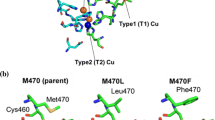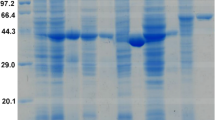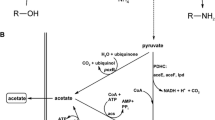Abstract
Bioelectronic interfaces that facilitate electron transfer between the electrode and a dehydrogenase enzyme have potential applications in biosensors, biocatalytic reactors, and biological fuel cells. The secondary alcohol dehydrogenase (2° ADH) from Thermoanaerobacter ethanolicus is especially well suited for the development of such bioelectronic interfaces because of its thermostability and facile production and purification. However, the natural cofactor for the enzyme, β-nicotinamide adenine dinucleotide phosphate (NADP+), is more expensive and less stable than β-nicotinamide adenine dinucleotide (NAD+). PCR-based, site-directed mutagenesis was performed on 2° ADH in an attempt to adjust the cofactor specificity toward NAD+ by mutating Tyr218 to Phe (Y218F 2° ADH). This mutation increased the K m(app) for NADP+ 200-fold while decreasing the K m(app) for NAD+ 2.5-fold. The mutant enzyme was incorporated into a bioelectronic interface that established electrical communication between the enzyme, the NAD+, the electron mediator toluidine blue O (TBO), and a gold electrode. Cyclic voltammetry, impedance spectroscopy, gas chromatography, mass spectrometry, constant potential amperometry, and chronoamperometry were used to characterize the mutant and wild-type enzyme incorporated in the bioelectronic interface. The Y218F 2° ADH exhibited a fourfold increase in the turnover ratio compared to the wild type in the presence of NAD+. The electrochemical and kinetic measurements support the prediction that the Rossmann fold of the enzyme binds to the phosphate moiety of the cofactor. During the 45 min of continuous operation, NAD+ was electrically recycled 6.7 × 104 times, suggesting that the Y218F 2° ADH-modified bioelectronic interface is stable.







Similar content being viewed by others
References
Armstrong, F. A., Heering, H. A., & Hirst, J. (1997). Reactions of complex metalloproteins studied by protein-film voltammetry. Chemical Society Reviews, 26(3), 169–179.
Halbhuber, Z., Petrmichlova, Z., Alexciev, K., Thulin, E., & Stys, D. (2003). Overexpression and purification of recombinant membrane PsbH protein in Escherichia coli. Protein Expression and Purification, 32(1), 18–27.
Park, D. H., Laivenieks, M., Guettler, M. V., Jain, M. K., & Zeikus, J. G. (1999). Microbial utilization of electrically reduced neutral red as the sole electron donor for growth and metabolite production. Applied and Environmental Microbiology, 65(7), 2912–2917.
Park, D. H., & Zeikus, J. G. (1999). Utilization of electrically reduced neutral red by Actinobacillus succinogenes: Physiological function of neutral red in membrane-driven fumarate reduction and energy conservation. Journal of Bacteriology, 181(8), 2403–2410.
Chen, T., Barton, S. C., Binyamin, G., Gao, Z. Q., Zhang, Y. C., Kim, H. H., et al. (2001). A miniature biofuel cell. Journal of the American Chemical Society, 123(35), 8630–8631.
Tsujimura, S., Fujita, M., Tatsumi, H., Kano, K., & Ikeda, T. (2001). Bioelectrocatalysis-based dihydrogen/dioxygen fuel cell operating at physiological pH. Physical Chemistry Chemical Physics, 3(7), 1331–1335.
Jornvall, H., Eklund, H., & Branden, C. I. (1978). Subunit conformation of yeast alcohol-dehydrogenase. Journal of Biological Chemistry, 253(23), 8414–8419.
Keinan, E., Hafeli, E. K., Seth, K. K., & Lamed, R. (1986). Thermostable enzymes in organic-synthesis 2. Asymmetric reduction of ketones with alcohol-dehydrogenase from Thermoanaerobium-Brockii. Journal of the American Chemical Society, 108(1), 162–169.
Keinan, E., Seth, K. K., & Lamed, R. (1987). Synthetic applications of alcohol-dehydrogenase from Thermoanaerobium-Brockii. Annals of the New York Academy of Sciences, 501, 130–149.
Heiss, C., Laivenieks, M., Zeikus, J. G., & Phillips, R. S. (2001). Mutation of cysteine-295 to alanine in secondary alcohol dehydrogenase from Thermoanaerobacter ethanolicus affects the enantioselectivity and substrate specificity of ketone reductions. Bioorganic & Medicinal Chemistry, 9(7), 1659–1666.
Tripp, A. E., Burdette, D. S., Zeikus, J. G., & Phillips, R. S. (1998). Mutation of serine-39 to threonine in thermostable secondary alcohol dehydrogenase from Thermoanaerobacter ethanolicus changes enantiospecificity. Journal of the American Chemical Society, 120(21), 5137–5141.
Kosjek, B., Stampfer, W., Pogorevc, M., Goessler, W., Faber, K., & Kroutil, W. (2004). Purification and characterization of a chemotolerant alcohol dehydrogenase applicable to coupled redox reactions. Biotechnology and Bioengineering, 86(1), 55–62.
Peretz, M., Bogin, O., TelOr, S., Cohen, A., Li, G. S., Chen, J. S., et al. (1997). Molecular cloning, nucleotide sequencing, and expression of genes encoding alcohol dehydrogenases from the thermophile Thermoanaerobacter brockii and the mesophile Clostridium beijerinckii. Anaerobe, 3(4), 259–270.
Schuhmann, W., Ohara, T. J., Schmidt, H. L., & Heller, A. (1991). Electron-transfer between glucose-oxidase and electrodes via redox mediators bound with flexible chains to the enzyme surface. Journal of the American Chemical Society, 113(4), 1394–1397.
Rosell, A., Valencia, E., Ochoa, W. F., Fita, I., Pares, X., & Farres, J. (2003). Complete reversal of coenzyme specificity by concerted mutation of three consecutive residues in alcohol dehydrogenase. Journal of Biological Chemistry, 278(42), 40573–40580.
Burdette, D. S., Vieille, C., & Zeikus, J. G. (1996). Cloning and expression of the gene encoding the Thermoanaerobacter ethanolicus 39E secondary-alcohol dehydrogenase and biochemical characterization of the enzyme. Biochemical Journal, 316, 115–122.
Burdette, D. S., Secundo, F., Phillips, R. S., Dong, J., Scott, R. A., & Zeikus, J. G. (1997). Biophysical and mutagenic analysis of Thermoanaerobacter ethanolicus secondary alcohol dehydrogenase activity and specificity. Biochemical Journal, 326, 717–724.
Kleifeld, O., Frenkel, A., Bogin, O., Eisenstein, M., Brumfeld, V., Burstein, Y., et al. (2000). Spectroscopic studies of inhibited alcohol dehydrogenase from Thermoanaerobacter brockii: Proposed structure for the catalytic intermediate state. Biochemistry, 39(26), 7702–7711.
Blaedel, W. J., & Jenkins, R. A. (1975). Study of electrochemical oxidation of reduced nicotinamide adenine-dinucleotide. Analytical Chemistry, 47(8), 1337–1343.
Prodromidis, M. I., & Karayannis, M. I. (2002). Enzyme based amperometric biosensors for food analysis. Electroanalysis, 14(4), 241–261.
Schmakel, C. O., Santhanam, K. S. V., & Elving, P. J. (1975). Nicotinamide adenine-dinucleotide (Nad+) and related compounds - electrochemical redox pattern and allied chemical behavior. Journal of the American Chemical Society, 97(18), 5083–5092.
Serban, S., & El Murr, N. (2004). Synergetic effect for NADH oxidation of ferrocene and zeolite in modified carbon paste electrodes - new approach of dehydrogenase based biosensors. Biosensors & Bioelectronics, 20(2), 161–166.
Emr, S. A., & Yacynych, A. M. (1995). Use of polymer-films in amperometric biosensors. Electroanalysis, 7(10), 913–923.
Heller, A. (1990). Electrical wiring of redox enzymes. Accounts of Chemical Research, 23(5), 128–134.
Degani, Y., & Heller, A. (1987). Direct electrical communication between chemically modified enzymes and metal-electrodes 1. Electron-transfer from glucose-oxidase to metal-electrodes via electron relays, bound covalently to the enzyme. Journal of Physical Chemistry, 91(6), 1285–1289.
Badia, A., Carlini, R., Fernandez, A., Battaglini, F., Mikkelsen, S. R., & English, A. M. (1993). Intramolecular electron-transfer rates in ferrocene-derivatized glucose-oxidase. Journal of the American Chemical Society, 115(16), 7053–7060.
Zayats, M., Katz, E., & Willner, I. (2002). Electrical contacting of flavoenzymes and NAD(P)(+)-dependent enzymes by reconstitution and affinity interactions on phenylboronic acid monolayers associated with Au-electrodes. Journal of the American Chemical Society, 124(49), 14724–14735.
Riklin, A., Katz, E., Willner, I., Stocker, A., & Buckmann, A. F. (1995). Improving enzyme-electrode contacts by redox modification of cofactors. Nature, 376(6542), 672–675.
Hassler, B. L., & Worden, R. M. (2006). Versatile bioelectronic interfaces based on heterotrifunctional linking molecules. Biosensors & Bioelectronics, 21(11), 2146–2154.
Oka, A., Sugisaki, H., & Takanami, M. (1981). Nucleotide-sequence of the Kanamycin Resistance Transposon Tn903. Journal of Molecular Biology, 147(2), 217–226.
Sambrook, J. M., Fritsch, E. F., & Maniatis, T. (1989). Molecular cloning: A laboratory manual (2nd edn.). Cold Springs Harbor, NY: Cold Springs Harbor Laboratory Press.
Ausubel, F. M., Brent, R., Kingston, R. E., Moore, D. D., Seidman, J. G., Smith, J. A., et al. (1993). Current protocols in molecular biology. New York, NY: Greene Publishing and Wiley-Interscience.
Burdette, D., & Zeikus, J. G. (1994). Purification of acetaldehyde dehydrogenase and alcohol dehydrogenases from Thermoanaerobacter-ethanolicus 39e and characterization of the secondary-alcohol dehydrogenase(2-Degrees Adh) as a bifunctional alcohol-dehydrogenase acetyl-Coa reductive thioesterase. Biochemical Journal, 302, 163–170.
Brooks, S. P. J. (1992). A simple computer-program with statistical tests for the analysis of enzyme-kinetics. Biotechniques, 13(6), 906–911.
Armstrong, R. D., Bell, M. F., & Metcalfe, A. A. (1977). Method for automatic impedance measurement and analysis. Journal of Electroanalytical Chemistry, 77(3), 287–298.
Mostany, J., & Scharifker, B. R. (1997). Impedance spectroscopy of undoped, doped and overoxidized polypyrrole films. Synthetic Metals, 87(3), 179–185.
Katz, E., & Willner, I. (1997). Kinetic separation of amperometric responses of composite redox-active monolayers assembled onto Au electrodes: Implications to the monolayers’ structure and composition. Langmuir, 13(13), 3364–3373.
Acknowledgments
The authors would like to thank the Michigan Technology Tri-Corridor (MTTC) program of the Michigan Economic Development Corporation (MEDC) and the IRGP programs at Michigan State University (MSU) for funding this work. Analytical support provided by the analytical chemistry facility in the MSU Department of Chemistry is also gratefully acknowledged.
Author information
Authors and Affiliations
Corresponding author
Rights and permissions
About this article
Cite this article
Hassler, B.L., Dennis, M., Laivenieks, M. et al. Mutation of Tyr-218 to Phe in Thermoanaerobacter ethanolicus Secondary Alcohol Dehydrogenase: Effects on Bioelectronic Interface Performance. Appl Biochem Biotechnol 143, 1–15 (2007). https://doi.org/10.1007/s12010-007-0027-2
Received:
Revised:
Accepted:
Published:
Issue Date:
DOI: https://doi.org/10.1007/s12010-007-0027-2




